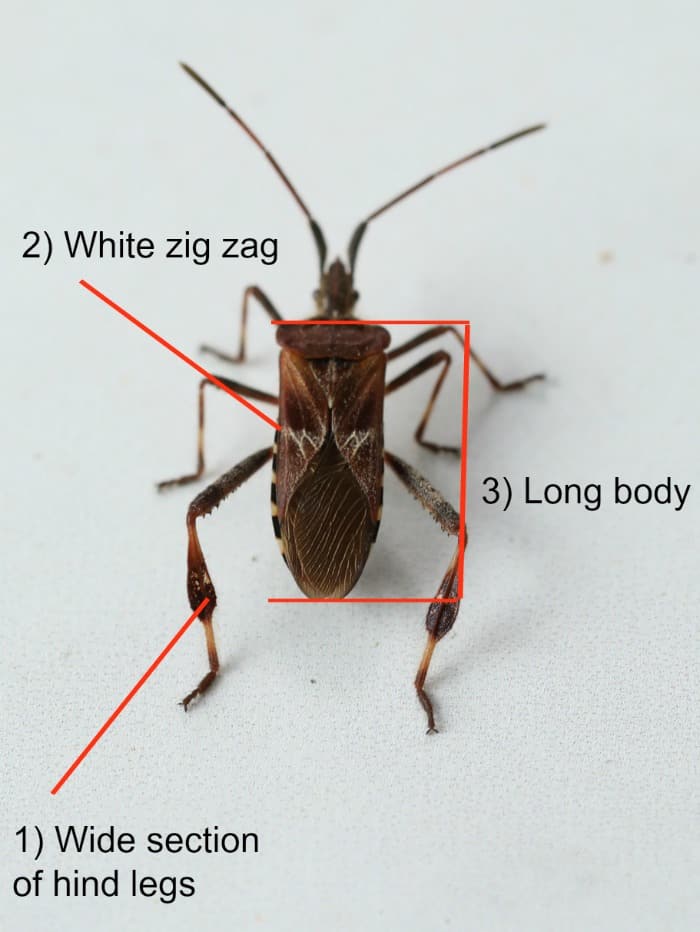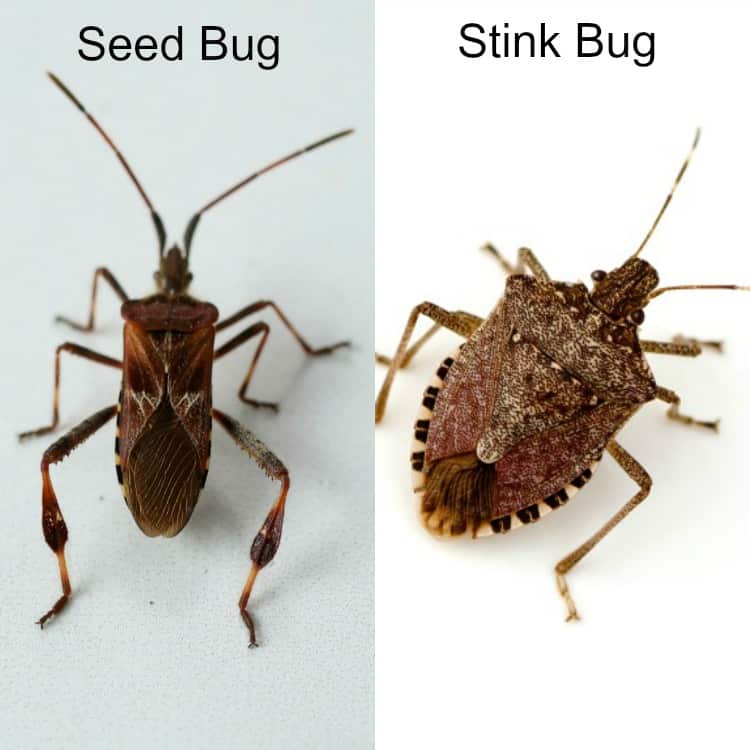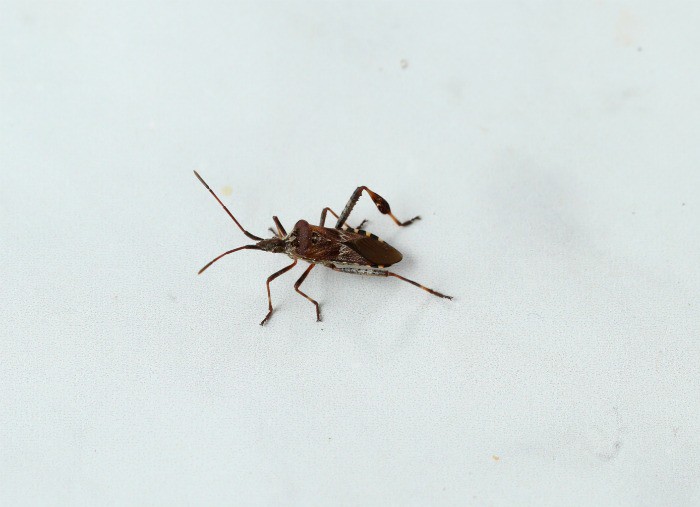The Conifer Seed Bug can cause a lot of concern as they try to make their way into your house. Learn how to identify, prevent, and remove these insects as well as others.
During the fall it’s not uncommon to see the Western Conifer Seed Bug lingering around your homes exterior. These insects were first discovered in the Western United States, but over time have made their way east.
The Seed Bug can be a disturbing site as they invade space around windows and doorways, usually on the sunnier sides of your home. Their main mission is to find a nice warm place to spend the winter months. They attempt to enter your home through it’s most vulnerable spots i.e., small cracks near windows and doors.
What Do Seed Bugs Look Like?
The Western Conifer Seed Bug has a body length of about 3/4”. It has several color variations along its body, ranging from light tan, to orange, and dark brown. The seed bug often gets confused with similar looking insects such as kissing bugs, or stink bugs. Seed bugs however can easily be identified by 3 unique characteristics:
1. The hind legs are distinctly widened for a small section toward the end of the leg.
2. There’s a pale white zig zag pattern on the wings.
3. Overall body is more lengthy as opposed to round.

Seed Bug Vs. Stink Bug
A lot of people mistakenly call Seed Bugs Stink Bugs. Perhaps the biggest reason is that when you kill a Seed Bug by squishing it, it will stink, just as bad as a Stink Bug. So people tend to refer to the two insects as being the same even though they are different:

You can see the Stink Bug is much rounder.
Another reason people tend to treat these two insects as the same is because other then some physical differences they are very similar in behavior.
Both Seed Bugs and Stink Bugs will try to enter your house when the weather is getting cold in fall. They will also become active in early spring and may try to enter your home in spring to avoid some of the colder days during the spring season.
They both usually seem to be lounging around, barely moving. When they do move they prefer to crawl slowly.
Another similarity is both don’t bite and overall they are harmless to humans.
Damage
Although creepy looking, Seed Bugs will not damage your home. They can however be a nuisance pest to your local ecosystem. Since adults feed on the seeds within pine cones, they prevent conifers from growing which can have negative effects in woodland ecosystems.
Lifecycle
In spring/early summer, adult Seed Bugs come out of their winter hide outs and feed on pinecones and seeds. After this period of feeding, Seed Bugs lay eggs on the needles of conifers.
After 10 days the eggs will hatch and the nymphs feed on pine cone scales and needles.
By mid August these nymphs become fully grown.
In early fall these adult Seed Bugs look to enter buildings and homes so they have a warm place to spend the winter so the cycle can start over again in the spring.
How to Get Rid of Seed Bugs
Manual removal is the best method for getting rid of these slow moving insects. If you find a Seed Bug inside your home, use a paper towel to pick it up and flush it down the toilet, or release back outside.
Another method is to fill a bowl with soapy water and use a paper towel to place them in the bowl.
Whatever you do, do not crush Seed Bugs in the paper towel, just pick them up gently. This will minimize the odor they give off. Crushing them is the worst thing you can do because they will give off a more intense odor.
Some people vacuum up Seed Bugs using a shop vac, and then release them outside. This isn’t the worst method, but it can still agitate them enough to release their odor.
How to Prevent Seed Bugs from Entering House
Preventing Seed Bugs from entering your house is much better then dealing with them once inside. The best part is if you follow these prevention steps you’re not only preventing Seed Bugs from entering, you’re preventing other home invaders such as Stink Bugs, Kissing Bugs, Asian Lady Beetles, and other insects.
1. Latch windows! Sounds simple enough but you’d be surprised how many people go through an entire winter with their window closed, but not latched. You can see as you latch your window how much tighter it seals the frame. Latching your window will likely decrease gaps by 1/4”. That’s all the space an insect needs to get through.
2. Caulk around windows, doors, pipe penetrations, and any other void along the exterior of your house. It’s not just windows and doors that insects can get through. Carefully inspect your home’s exterior for any small cracks or openings.
3. Make sure screens are in place and repair any that are damaged. This adds another barrier to your windows.
4. Apply insecticide barrier sprays on outside of house. This should be used as a last resort for more serious infestations. Products that contain the chemical Permethrin have been proven to prevent Seed Bugs. This insecticide should be used as a barrier spray and sprayed around your homes foundation, doors, and window frames, all on the exterior of your house.
5. Hire a pro! Hiring your local bug guy is always a great idea if you think you have an infestation that requires extra attention. There’s never anything wrong with getting some professional opinions. A local, licensed company will be up to date on local restrictions and codes and will be able to give you the best advice on how to treat the problem.
Check Out These Posts Next
White Grubs: Prevention and Treatment
Protecting Evergreens from Winter Burn
Follow Me
Join my free email list!



Hi Mark. Thank you for helping me identify this pesky bug that’s been taunting me for months! My office is on the sunny side of the house which explains why I’ve encountered more of these pests than my parents who are located on the opposite side of the house.
I have been captureing these little buggers one by one and returning them to the great outdoors using a plastic cup and paper plate. I know I’m awful but I secretly hope they’re a light snack for a hungry bird!
Anyways, I would say I’m removing these at least three to four times a week. I will take your advice and check the seals on the windows and the latches. However, I must confess that I’m a bit of an alarmist when it comes to crawly things. Should I be concerned that there’s breeding going inside the house and that these bugs will eventually invest it?
Thanks for any advice you can give!
Best,
Linda
Hi Linda! I can’t believe how many I have around my house this year too! They have just started to calm down over here in NH since the temperatures have dropped. One thing I can assure you is that you don’t have to worry about them mating inside your house. They go outside in the spring and lay eggs on needles and leaf stems. If there’s one positive in all this is if they get into your house they really don’t do much. They won’t be multiplying, or chewing wires or anything like that.
I live in PA and bought a camper from a guy over in New York, about 2.5 hours away from where I live. We cleaned the camper, but on our first trip with it to the Allegheny Mountains, we encountered these bugs. I’m sorry but they’re what nightmares are made of! We’ve killed a handful of them (between 5-7) and I hope we don’t find anymore! We’re on our second trip with it and have caught 3-4 this time! It’s April 30th so hopefully they’ll go out to the trees soon and we’ll never see them again! Last night I was sleeping and around 430am, I heard a buzz noise and a few seconds later, one was crawling in my shirt under my arm! I flung it off and I couldn’t find it, but it did smell bad and I took my T-shirt off and smoked a cigarette and the smell subsided. It felt like its feet were sticky and was creepy that it was on me! We just found another one this evening, it just appeared on the window shade, which is what prompted me to look them up. I’m so glad to know that they don’t really have any reason to bite (even though there are a few cases where it was documented that they bit someone).
Hi Angela! Ya these creep my daughter out pretty good here in NH. Luckily like you said they will be moving out of the house pretty soon to head into the woods. It’s amazing how they sneak their way in!
Thank you Mark for your excellent detailed report of this pesky Western Conifer Beetle. Your photos and descriptions of this type of Beetle is relieving me already.
We are being inundated daily by these “pest” and as you say are quite harmless.
However, are a nuisance, we simply use a handheld vacuum to rid them.
At this point we will double check the ways they get in, use the recommended pesticide outside or preferably have an exterminator come out.
While they do bug me it’s embarrassing when others visiting spot them. Time consuming too hunting them down.
Question: Are they here to stay?
Hi Anne, honestly there’s not much you can do to fight the force of nature on this one. All you can really do is protect your house and keep it tight so they can’t get in. One thing you can do is keep the yard tidy and make sure there aren’t leaf or brush piles around. You could check locally for companies that offer barrier sprays but I know that for me locally those options are limited. No harm in checking with a local company though. Also, don’t forget that as the temps warm up they shouldn’t be so present around the house as they will move into the woods.
Thank you so much for your time and input. I think once we get our grounds landscaped it will help – your comment about brush and earth makes sense. We are just now working on landscape and removal of this “ new build home “ ground around our home…. Still hoping tho’ to find an exterminator for around our windows. FYI we happen to live in close proximity to the various Pines, dirt and nature! little did we know! Thanks again you have been a big help.
Hi, Mark; I’m in Montana and these bugs are everywhere, although lessening with cooler weather. I’m wondering if there is a natural predator that I could lure to my property? Are there any birds, for example that eat them?
Thank you
Hi Jenny, that’s a great question, and to be honest I’m not really sure. I do know that any other insect eating insect would eat them, but you’d just be introducing more insects to the property. For the first two years I moved into my new house I had them really bad. I was persistent in sucking them up and killing them and now I barely have them. Just something to think about!
Hi Mark, I live in southeastern MA. We are inundated with these yucky things! I first noticed them on my back screened in porch, both inside and outside. I sprayed them with insecticidal soap using Dawn. It works great. Then I noticed a few climbing up the fireplace on the inside of my house! I saturated the area and sprayed each bug when I I saw one. I just moved the fp screen away because I kept smelling that awful stink bug smell and I almost fell over! There must have been over 100 dead seed beetles in the hearth! They are/were coming in through the chimney!
Thanks for helping me identify these critters!
Diane
oh wow, that’s crazy Diane! They’ve been all over my house last couple of days with all the sun. I made sure all window are latched. It’s good to know you had success with insecticidal soap. The good news is it’s a fairly quick season where they try to work their way in.
Mark,
I live in the upper part of Michigan in the lower peninsula; and, it seems these pests have become worse each year. I kill approximately 5-6 a day 😵! I went around my house and noticed 3 windows closed but not latched, they are all latched now. We have some conifer trees on our property, but more apple trees. Do these bugs live in apple trees or just conifers?
Thank you,
Linda
Hi Linda, they’re really known for feeding and developing on conifers, you should be ok with apple trees. They were really bad this year around my house. Luckily not many made there way inside, but during the warmer sunny days they definitely love to hang out on the outside of the house, trying to get in.
I’ve got one living in the plants in my office. It’s freezing and snowing outside so I don’t have the heart to throw him out (just yet). He really is a curious fellow – I don’t see him during the day but when I play my guitar he sits on the desk and watches me. Maybe he’s attracted to the vibrations? I’ve called him George (after Harrison)
Hahah, that’s pretty funny. Sounds like a good pet!